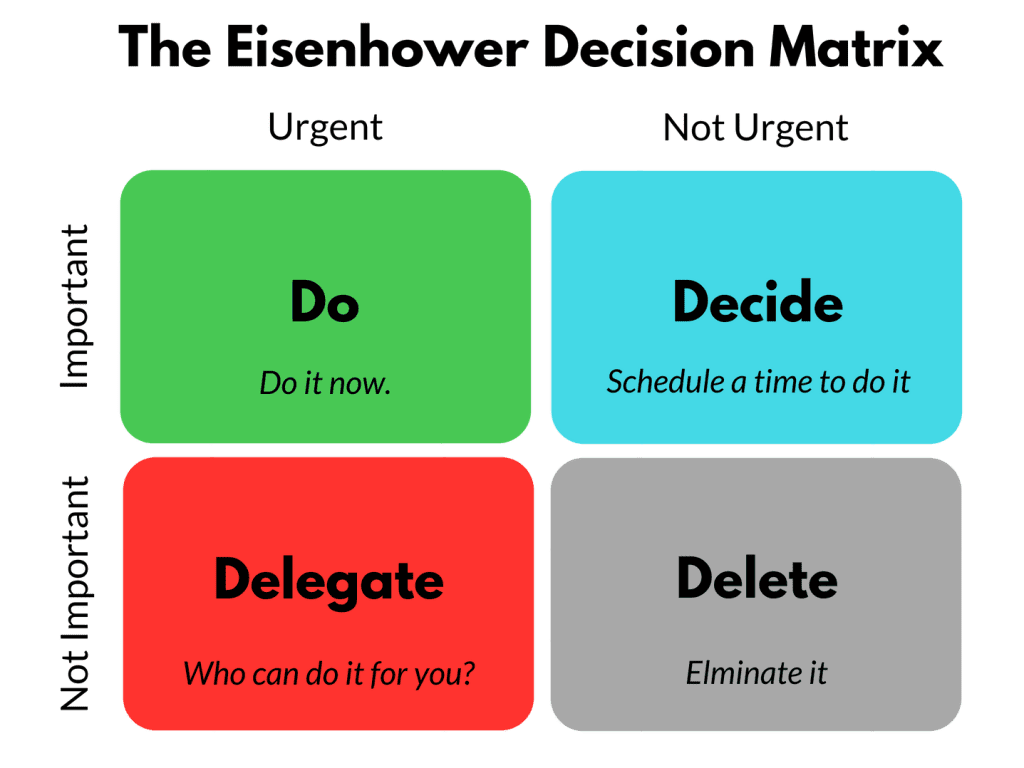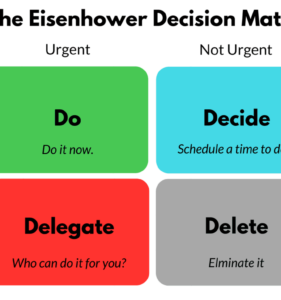Introduction
In the fast-paced world of today, making decisions can often feel overwhelming. Whether it’s managing tasks at work or handling personal responsibilities, the ability to prioritize effectively is crucial for success. This is where the Eisenhower Decision Matrix comes into play. Named after Dwight D. Eisenhower, the 34th President of the United States and a former General of the Army, this matrix offers a structured approach to decision-making, helping individuals distinguish between urgent and important tasks. In this comprehensive guide, we’ll delve into the benefits of using the Eisenhower Decision Matrix and provide a step-by-step process for its implementation.
Understanding the Eisenhower Decision Matrix
The Eisenhower Decision Matrix is a simple yet powerful tool that categorizes tasks based on their urgency and importance. It consists of four quadrants:
- Important and Urgent: Tasks in this quadrant require immediate attention and should be dealt with promptly.
- Important but Not Urgent: Tasks in this quadrant are important for long-term goals but do not require immediate action. They should be scheduled and prioritized accordingly.
- Urgent but Not Important: Tasks in this quadrant may seem urgent but do not contribute significantly to long-term goals. Delegation or elimination of these tasks is often the best approach.
- Not Urgent and Not Important: Tasks in this quadrant are neither urgent nor important and should be eliminated or minimized.
By categorizing tasks into these four quadrants, individuals can make informed decisions about where to focus their time and energy, thereby increasing productivity and reducing stress.
The four D’s of the Eisenhower Decision Matrix are:
- Do: Tasks that are both urgent and important, requiring immediate action.
- Delegate: Tasks that are urgent but not important, which can be delegated to others.
- Delay: Tasks that are important but not urgent, to be scheduled for later action.
- Delete: Tasks that are neither urgent nor important, to be eliminated or minimized.
Understanding the difference between urgent and important tasks is crucial for effective prioritization and decision-making. While these terms are often used interchangeably, they represent distinct concepts:
Urgent Tasks
Urgent tasks are those that require immediate attention or action. They typically have a deadline or time constraint associated with them, and failing to address them promptly may result in negative consequences. Urgent tasks often demand immediate action due to external pressures or deadlines imposed by others.
Examples of urgent tasks include:
- Responding to emails marked as urgent
- Meeting a deadline for a project or assignment
- Attending to an unexpected crisis or emergency
Important Tasks
Important tasks, on the other hand, are those that contribute significantly to your long-term goals, values, or objectives. These tasks may not necessarily have an immediate deadline or time pressure associated with them, but they are crucial for personal or professional growth and success. Important tasks align with your priorities and values, and investing time and effort in them can lead to meaningful outcomes.
Examples of important tasks include:
- Planning and strategizing for future projects or goals
- Investing in personal development or skill enhancement
- Building and nurturing relationships with clients, colleagues, or loved ones
Key Differences
- Time Sensitivity: Urgent tasks are time-sensitive and require immediate action, while important tasks may not have an immediate deadline but contribute to long-term success.
- External vs. Internal Priorities: Urgent tasks are often driven by external factors such as deadlines or requests from others, while important tasks are driven by internal priorities and values.
- Consequences: Failing to address urgent tasks promptly may lead to immediate negative consequences, while neglecting important tasks may have long-term implications for personal or professional growth.
- Focus and Alignment: Urgent tasks often demand attention, but they may not always align with long-term goals or priorities. Important tasks, on the other hand, reflect your values and priorities and contribute to meaningful outcomes.
Benefits of Using the Eisenhower Decision Matrix
1. Enhanced Productivity
One of the primary benefits of using the Eisenhower Decision Matrix is its ability to enhance productivity. By prioritizing tasks based on their importance and urgency, individuals can ensure that they are focusing on activities that align with their goals and objectives. This leads to greater efficiency and effectiveness in completing tasks.
2. Reduced Stress
Another significant benefit of the Eisenhower Decision Matrix is its potential to reduce stress. By clearly defining which tasks are urgent and important, individuals can avoid the feeling of being overwhelmed by an endless to-do list. Instead, they can tackle tasks systematically, knowing that they are focusing on what truly matters.
3. Improved Time Management
The Eisenhower Decision Matrix encourages individuals to allocate their time wisely by focusing on tasks that have the greatest impact. By prioritizing important tasks over urgent but less significant ones, individuals can make better use of their time and resources, leading to improved time management skills.
4. Increased Clarity and Focus
By categorizing tasks into four distinct quadrants, the Eisenhower Decision Matrix provides individuals with clarity and focus regarding their priorities. This clarity enables them to make decisions more confidently and reduces the likelihood of getting sidetracked by less important tasks.
5. Better Decision-Making
Ultimately, the Eisenhower Decision Matrix is a tool for better decision-making. By forcing individuals to evaluate the importance and urgency of each task, it helps them make more informed choices about where to allocate their time and resources.
Step-by-Step Guide to Using the Eisenhower Decision Matrix
Step 1: List Your Tasks
The first step in using the Eisenhower Decision Matrix is to list all of your tasks. This can include work-related assignments, personal responsibilities, and any other activities that require your attention.
Step 2: Assess Importance
Once you have listed your tasks, the next step is to assess their importance. Ask yourself which tasks are essential for achieving your long-term goals and objectives. These tasks will fall into the “Important” category.
Step 3: Evaluate Urgency
After assessing importance, the next step is to evaluate urgency. Determine which tasks require immediate action and which ones can be deferred. Tasks that are both important and urgent will fall into the corresponding quadrant.
Step 4: Prioritize Tasks
With a clear understanding of each task’s importance and urgency, it’s time to prioritize them accordingly. Focus on completing tasks that are both important and urgent first, followed by those that are important but not urgent. Delegate or eliminate tasks that are urgent but not important, and minimize or eliminate tasks that are neither urgent nor important.
Step 5: Take Action
The final step in using the Eisenhower Decision Matrix is to take action. Start by tackling tasks in the “Important and Urgent” quadrant, then move on to those in the “Important but Not Urgent” quadrant. Delegate or eliminate tasks in the “Urgent but Not Important” quadrant, and minimize or eliminate tasks in the “Not Urgent and Not Important” quadrant.
By following these five steps, you can effectively prioritize your tasks and make informed decisions about where to focus your time and energy, leading to increased productivity and reduced stress.
Eisenhower Decision Matrix
The Eisenhower Decision Matrix is a valuable tool for effective decision-making and prioritization. By categorizing tasks based on their importance and urgency, individuals can enhance productivity, reduce stress, improve time management, increase clarity and focus, and make better decisions overall. By following the step-by-step guide outlined in this article, you can harness the power of the Eisenhower Decision Matrix to achieve your goals and objectives more efficiently.


